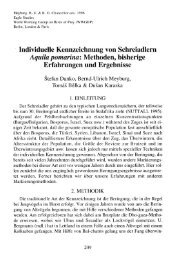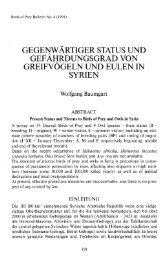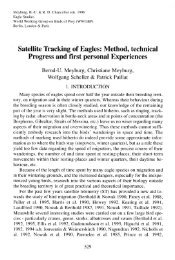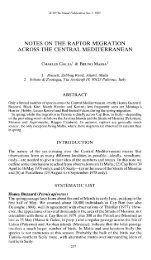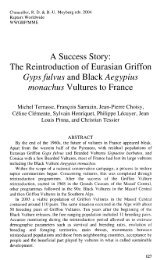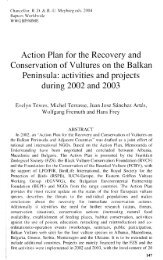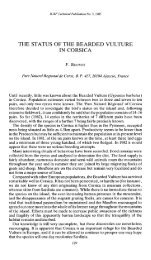Algunos aspectos del gregarismo invernal del Búho ChicoAsio otus ...
Algunos aspectos del gregarismo invernal del Búho ChicoAsio otus ...
Algunos aspectos del gregarismo invernal del Búho ChicoAsio otus ...
Create successful ePaper yourself
Turn your PDF publications into a flip-book with our unique Google optimized e-Paper software.
Long-eared Owl roosting behaviour was studied in three pine-forests<br />
in the province of Salamanca (central Spain), for 8 consecutive winters (period<br />
1987-1995).<br />
If seems that the site selection for such communal roost-sites is due to<br />
high prey availability (rodents). It is suggested, too, that a likely relation exists<br />
between these aggregations and two vole plagues ( Micr<strong>otus</strong> arvalis) that<br />
occurred during that period.<br />
In the study area, the Long-eared Owls start to show their gregarious<br />
behaviour in September-October (agrégations of 5-10 individuals), and then,<br />
increase their number with the arrival of migrant and dispersing birds, reaching<br />
the highest concentrations in December-January (27 birds on 18th December<br />
1990). Communal roosts dwindle in February.<br />
Another aspect which has been studied is the criteria of roost-tree<br />
selection, it being estimated that important variables in such selection might<br />
be the thickness of the top of the tree (mainly, they roost in pines with dense<br />
tops), and its peripheral location within the pine-forest, as a measure to provide<br />
quick access to the hunting areas situated in the nearby cereal fields.<br />
INTRODUCTION<br />
El comportamiento gregario <strong>del</strong> <strong>Búho</strong> Chico (Asió <strong>otus</strong>) durante la época<br />
post-nupcial e <strong>invernal</strong> (correspondiente a otoño-invierno), ha sido citado<br />
anteriormente por diversos autores, tanto en la Península Ibérica (Araújo et<br />
al, 1974; Veiga, 1981; Gil et al., 1983; Hernández & Alegre, 1988), como en<br />
el resto de Europa (Cramp, 1985).<br />
Los datos aportados en este artículo pretenden contribuir al mejor<br />
conocimiento de esta faceta <strong>del</strong> comportamiento <strong>del</strong> <strong>Búho</strong> Chico.<br />
AREA DE ESTUDIO Y MÉTODOS<br />
El estudio fue realizado en tres "pinares-isla", situados en el cuadrante<br />
NE de la provincia de Salamanca, España Central (Fig 1). El primer pinar<br />
objeto de estudio, se encuentra situado en el término municipal de Aldeaseca<br />
de Armuña; con 14,6 Has. de extensión, está formado principalmente por<br />
pinos piñoneros ( Pinus pinea) y resineros (P. pinaster) existiendo una pequeña<br />
zona con encinas ( Q. rotundifolia), alcornoques (Q. súber) y quejigos (Q.<br />
faginea).<br />
Los otros dos pinares, bastante más pequeños, se localizan en los<br />
términos municipales de Zorita de la Frontera y Palaciosrubios. Sus superficies<br />
- 452 -



